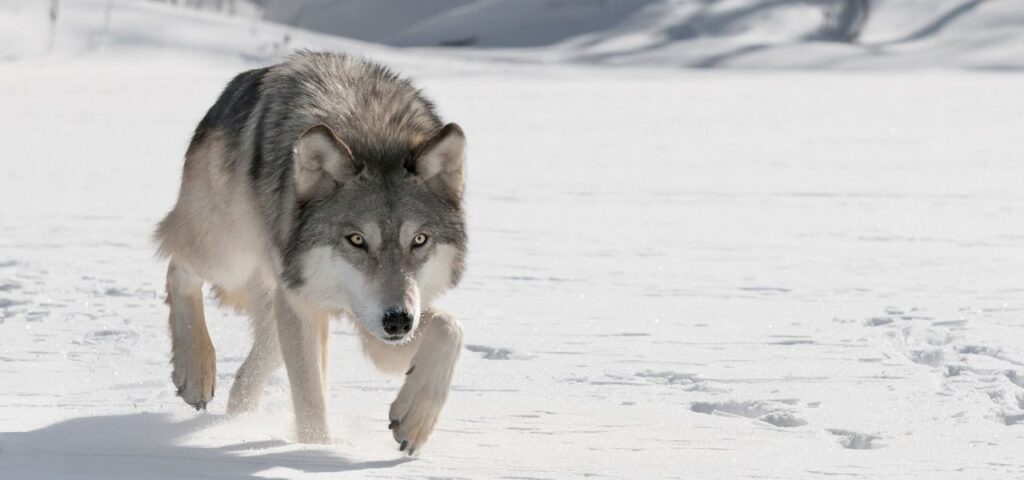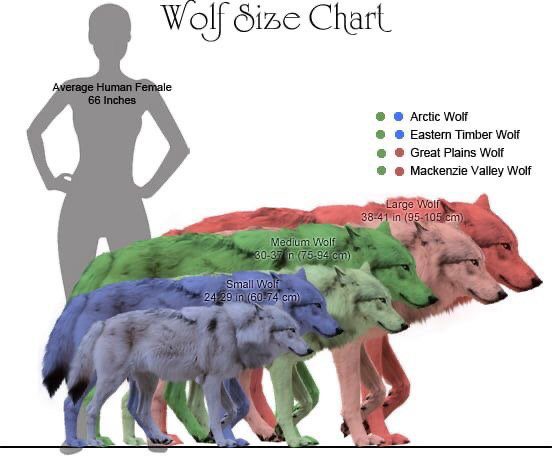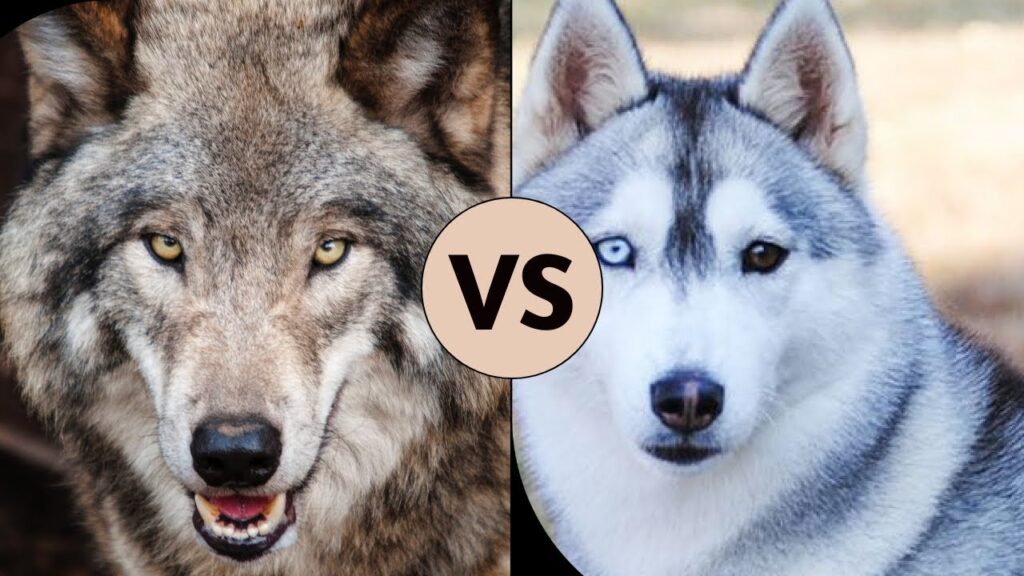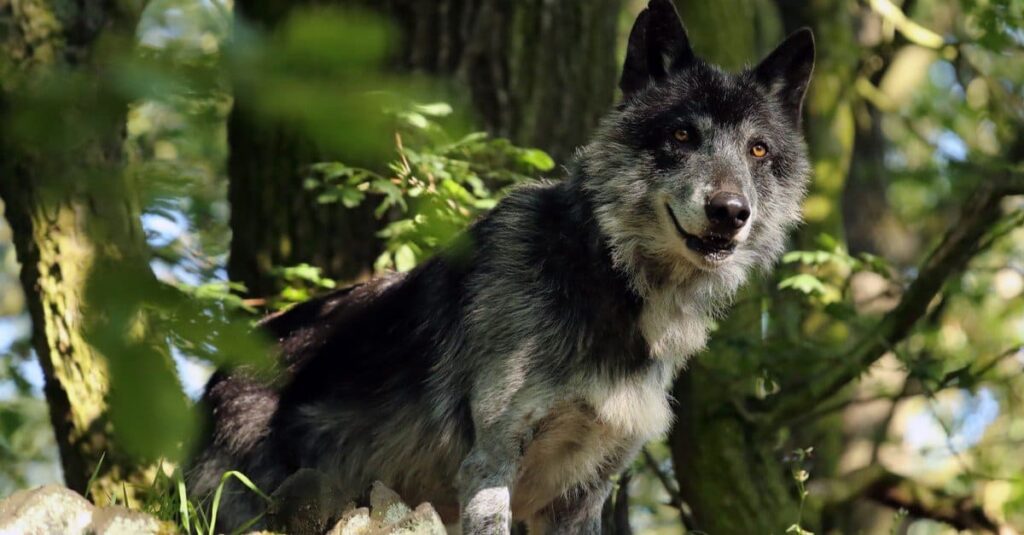Welcome to BungeeCity.com, where we dive into the wild world of wolves! Have you ever wondered just how big these majestic creatures can get? Well, prepare to be amazed as we embark on a size comparison adventure, pitting wolves against dogs and even us humans. From jaw-dropping subspecies variations to surprising extremes, we’ll unravel the mysteries behind their impressive dimensions. So, brace yourself, because you’re about to uncover the answer to the age-old question: “How big are wolves, really?” Get ready to be howling with laughter and awe as we take a deep dive into the fascinating world of wolf sizes.
Understanding the Size of Wolves

gray wolf
Renowned for their imposing stature and mesmerizing presence, wolves, particularly the Gray Wolf (Canis Lupus), command respect in the wild. Their grandeur is only rivaled by their vast distribution, stretching across the verdant terrains of North America, the dense forests of Eurasia, and the arid landscapes of the Middle East. As the largest wild member of the Canidae family, their significance in maintaining the health of our ecosystems is unrivaled, as they deftly control the population of prey species.
Imagine standing face to face with a wolf, the moonlight casting long shadows as it towers over you. The Gray Wolf, also known as the timber wolf, is a creature of such formidable size. Its grand stature and awe-inspiring presence are truly a sight to behold in the wild, echoing its pivotal role in maintaining the delicate balance of ecosystems.
| Type of Wolf | Size |
|---|---|
| Gray Wolf (Canis Lupus) | Length: 3.9 to 6.8 feet (including tail) Height: 31 to 33 inches at the shoulder Weight: 70 to 130 pounds |
| Mackenzie Valley Wolf (Canis Lupus Occidentalis) | Up to 7 feet from nose to tail tip |
Within the Gray Wolf species, the Mackenzie Valley Wolf (Canis Lupus Occidentalis), also known as the Alaskan Timber Wolf, holds the title of the largest subspecies. Picture a wolf that stretches up to 7 feet from nose to tail tip – a sight that would indeed be awe-inspiring and intimidating in the wild.
With such a wide variety of wolves and their sizes, it’s clear that these creatures are formidable in size. Whether it’s the towering Gray Wolf, matching a human in height when standing on its hind legs, or the smaller yet uniquely adapted Ethiopian Wolf, these majestic creatures continue to fascinate us with their size and strength.
Join us as we delve deeper into this topic in the following sections, comparing the size of wolves with familiar domestic canids such as dogs, and even us humans. Let’s embark on this journey to better understand these magnificent creatures that roam our planet.
Unraveling the Majestic Proportions of Wolves

size comparison
Imagine standing face to face with a creature of immense power, its eyes burning with wild intensity, its body a testament to the harsh yet beautiful wilderness from which it hails. This is the awe-inspiring presence of the wolf, a beast whose size often leaves us spellbound.
When you delve into the dimensions of wolves, you’ll find a fascinating spectrum. The size of these majestic creatures varies significantly, painting a wide canvas of diversity in the wolf family. On average, a wolf measures an impressive 4.5 to 6.5 feet in length, including the tail. This is akin to the height of an average human adult when standing, a fact that serves to underline the sheer size of these beasts. It’s not just the length that’s astounding but also their height. From their paws to their shoulders, wolves stand at a towering height of 26 to 32 inches, making them one of the tallest canids.
But that’s not all. The weight of wolves is another aspect that demands our attention. These creatures, molded by the unforgiving wilderness, can weigh anywhere from 50 to a staggering 180 pounds. This dramatic range is dictated by factors such as gender, age, diet, and subspecies, a topic we will delve into in the upcoming sections.
Read all about: What Makes Bungee Jumping vs Skydiving More Dangerous?
It’s worth noting that the heaviest wolves can weigh as much as an average adult human. This fact alone speaks volumes about their strength and hunting prowess. However, despite their size, wolves are known for their agility and endurance, qualities that make them not just effective predators, but also symbols of untamed wilderness.
As we continue our journey into the world of wolves, we will explore the different subspecies and their sizes, offering a deeper understanding of this majestic animal. From the Arctic tundra to the dense forests of Eurasia, each subspecies has evolved unique physical attributes, adapting to their specific environments, further adding to the wolf’s rich tapestry of diversity.
Subspecies and Their Sizes: An In-Depth Exploration
When we think of wolves, we often envision a singular image of a large, powerful creature. However, the reality is far more complex and intriguing. The Gray Wolf, for instance, is a species that boasts an impressive 32 subspecies, each exhibiting a wide range of sizes and physical characteristics, much like an extended family with a colorful array of relatives. To truly grasp the diversity within the wolf family, let’s delve into the specifics of four distinct subspecies, moving from the smallest to the largest.
The Petite Predators
Beginning our journey, we encounter the Arabian Wolf. This is by no means the largest member of the family, but don’t let its size fool you. This subspecies, native to the Arabian Peninsula, is a compact powerhouse. With a length of 3.2 to 4 feet (including tail) and standing 26 inches at the shoulder, they weigh in between 45 to 50 pounds. They’re lean, agile, and perfectly suited to their environment.
Next, we meet the Indian Wolf. With a slightly larger stature, they measure 3 to 3.5 feet in length (including tail), stand 24 to 38 inches at the shoulder, and weigh between 55 to 77 pounds. This subspecies, found in the arid and semi-arid regions of the Indian subcontinent, carries an air of fierce resilience that is truly a sight to behold.
The Majestic Beasts
Moving on to the larger cousins in the family, we come across the Eurasian Wolf. This subspecies holds a widespread presence across Eurasia, and their size is a testament to their dominance. With a length ranging from 3.9 to 6.8 feet (including tail), a shoulder height of 31 to 33 inches, and a weight of 70 to 130 pounds, they are a formidable presence in the wild.
Finally, we arrive at the pinnacle of wolf sizes with the Mackenzie Valley Wolf, also known as the Alaskan Timber Wolf. This subspecies is the embodiment of the majestic wolf image that we often visualize. With a staggering length of 5 to 7 feet (including tail), standing 33 to 36 inches at the shoulder, and weighing between 100 to 145 pounds, they are truly the giants among the wolves.
In conclusion, the world of wolves is a tale of diverse sizes and adaptations. From the petite Arabian Wolf to the towering Mackenzie Valley Wolf, each subspecies carries a unique story of evolution and survival. Stay with us as we further dive into size comparisons with dogs and humans in the following sections.
Wolf Size Comparison with Dogs and Humans: A Detailed Analysis
Imagine standing face-to-face with a Gray Wolf, the largest of all wolf species. Its piercing gaze is level with yours as it stands tall on its hind legs. Its powerful frame extends from 4.5 to 6.5 feet in length, including the tail, and its weight is a force to be reckoned with, ranging from 50 to 180 pounds. The heaviest wolves tip the scales at the same weight as an average adult human, presenting a picture of nature’s raw power and grandeur.
So, how does this remarkable creature compare in size to our familiar companions, dogs, and to us humans? Let’s delve into a comparative analysis to better understand the dimensions of these magnificent animals.
Gray Wolf vs. Great Dane: A Clash of Titans
If you have ever marveled at the towering stature of a Great Dane, you would be astounded to learn that this breed, one of the tallest in the dog world, can match or even exceed the shoulder height of a wolf. The average height of a Great Dane, standing between 28 and 34 inches tall, is comparable to the Gray Wolf’s average height of 26 to 32 inches at the shoulder. However, when it comes to body length and weight, the Gray Wolf surpasses the Great Dane, presenting a broader and more imposing figure. Other wolf species, such as the Red Wolf, Ethiopian Wolf, and Maned Wolf, although majestic in their own right, generally fall short in length and weight compared to the Great Dane.
Siberian Huskies and Wolves: A Study in Contrast

wolf and husky
Many people associate the Siberian Husky with the classic image of a wolf, thanks to their strikingly similar appearances. However, beneath the surface, the similarities taper off. Siberian Huskies, with their height ranging from 20 to 23.5 inches at the shoulder and weight between 35 to 60 pounds, are significantly smaller than even the smallest wolf species like the Ethiopian Wolf. This comparison underscores the sheer size and stature of wolves, emphasizing their status as one of nature’s most formidable creatures.
Read about: Extreme Sports vs Adventure Sports: Which Thrill-Seeking Experience is Right for You?
Through these comparisons, we can better appreciate the size and strength of wolves. Whether standing tall like a Great Dane or dwarfing a Siberian Husky, wolves truly are a testament to nature’s grand design. As we move forward, we will continue to explore the fascinating world of wolves, comparing their sizes with other wild animals, and delving into the extremes in wolf sizes.
Wolf Size Comparison with Other Wild Animals
When we bring other wild animals into the picture, the immensity of the wolf becomes even more apparent. If we trace the footprints of nature’s design, we’ll find that wolves tower over many of their counterparts in the wilderness.
Let’s start with the coyote, a creature often mistaken for a wolf due to their similar appearance. However, when you look closely, a stark difference in size emerges. Wolves are notably larger than coyotes in every aspect. An adult coyote, standing with a shoulder height of 21 to 24 inches and a body length ranging from 3.3 to 4.5 feet, pales in comparison to the grandeur of any wolf species.
The wolf, a majestic creature of the wilderness, profoundly dwarfs the coyote in terms of size and weight.
Next, let’s turn to the fox, another member of the Canidae family. The size discrepancy between wolves and foxes is even more substantial. The largest fox species, the Red Fox, stands only 14 to 16 inches tall at the shoulder. The heaviest fox, on the other hand, weighs only up to 15 pounds. This is a mere fraction when compared to the wolf, which can range from 40 to 180 pounds.
On the African savannah, one might find the African Wild Dog, also known as the painted dog or Cape hunting dog. Despite its lean and agile appearance, the African Wild Dog is smaller than all wolf species. An adult African Wild Dog stands about 24 to 30 inches tall at the shoulder, measures up to 4.6 feet long, including the tail, and weighs between 40 to 80 pounds.
When we venture further into the wild, we encounter the hyena. While wolves are generally taller and longer than most hyena species, the weight of wolves can be comparable to that of some hyenas, especially the Spotted Hyena. However, the wolf’s robust build gives it a size advantage over the leaner and shorter hyena.
So, as we wander through the wilderness, we see that the wolf, in all its grandeur, is a formidable figure among its wild counterparts, truly a testament to nature’s majesty.
The Extremes in Wolf Sizes: From the Majestic Mackenzie Valley Wolf to the Petite Ethiopian Wolf

Mackenzie Valley Wolf
The world of wolves is truly a spectacle to behold, ranging from behemoths that tower over other wild animals to relatively petite species that still carry the same fierce spirit of their larger counterparts. In their diversity, we discover nature’s grand design and its stunning ability to produce creatures of varying sizes and strengths, each perfectly adapted to their unique environments.
At the top of the size spectrum, reigning supreme, is the Gray Wolf (Canis Lupus Lupus). Within this species, the Mackenzie Valley Wolf (Canis Lupus Occidentalis) stands out as the largest subspecies, also known as the Alaskan Timber Wolf. These magnificent creatures, with their imposing stature and powerful build, are a sight to behold. Exceptional individuals of this subspecies often exceed lengths of up to 7 feet from nose to tail tip and can weigh between 100 and 145 pounds. Imagine a creature that could almost match the size of an average adult human lying down, and you have the Mackenzie Valley Wolf.
The Mackenzie Valley Wolf: A testament to the power and grandeur of nature, these wolves are larger than most dogs and even some wild animals.
On the other end of the spectrum, showcasing nature’s diversity, is the Ethiopian Wolf (Canis Simensis), the smallest species of wolf. Despite their smaller size, these wolves carry the same wild spirit and fierceness as their larger counterparts. An Ethiopian Wolf measures approximately 3 to 3.5 feet in length, stands about 25 inches at the shoulder, and typically weighs between 40 to 60 pounds. These wolves, with their reddish coats and coyote-like appearance, are a testament to the adaptability and variability within the wolf species.
The Ethiopian Wolf: Despite their size, these wolves are fierce, adaptable, and perfectly suited to their high-altitude, rocky habitats.
Whether it’s the stunning size of the Mackenzie Valley Wolf or the smaller, yet equally fierce Ethiopian Wolf, the spectrum of wolf sizes demonstrates the incredible diversity and adaptability of these creatures. As we delve deeper into the world of wolves, it’s clear that size doesn’t determine the spirit and survival skills of these remarkable animals.
Conclusion
As we journey through the wild landscapes of our world, we come face to face with the true kings and queens of their respective realms, the wolves. Their size, from the towering stature of the Gray Wolf to the petite dimensions of the Ethiopian Wolf, speak volumes about their roles as apex predators in the ecosystem.
The wolf’s anatomy is a marvel of nature’s design. A robust body, deep chest, and powerful limbs often endow them with an imposing appearance, even when compared to other animals of similar, or in some cases, larger sizes. This element of their physique is not just for show. It’s a testament to their survival instincts, adaptability and their position in the food chain.
The Mackenzie Valley Wolf, for instance, is a paragon of strength and agility. With its size reaching lengths of up to 7 feet and weighing between 100 and 145 pounds, it’s no wonder that it commands respect and fear in equal measure. On the other hand, the Ethiopian Wolf, despite its smaller size, is no less formidable. Measuring approximately 3 to 3.5 feet in length and weighing between 40 to 60 pounds, it exhibits a fierce spirit and adaptability that matches, if not surpasses, its larger counterparts.
Whether it’s the gray wolf matching a human in height when standing on its hind legs, or the smaller red wolf that is larger than a coyote but dwarfed by the Great Dane, each species of wolf holds a unique position in terms of size. It’s a fascinating tapestry of nature’s diversity woven with strands of evolution, adaptation, and survival.
Understanding the size of wolves is not just about numbers and comparisons. It’s about appreciating their roles as guardians of the wild, their interactions with other species, and the intricate balance they help maintain in their ecosystems. Their size, in essence, is a reflection of their role in the grand theater of life.
Wolves can vary in size depending on the subspecies, but on average, they measure 4.5 to 6.5 feet in length (including the tail) and stand 26 to 32 inches tall at the shoulder. They can weigh anywhere from 50 to 180 pounds.
In terms of body length and weight, wolves can match or surpass the Great Dane, one of the world’s tallest dog breeds. However, the Great Dane can match or exceed the shoulder height of a wolf.
While Siberian Huskies are often compared to wolves in appearance, they are significantly smaller in size. Siberian Huskies stand about 20 to 23.5 inches tall at the shoulder and weigh between 35 to 60 pounds, whereas wolves can stand up to 32 inches tall at the shoulder and weigh between 50 to 180 pounds.
Wolves are notably larger than coyotes, with coyotes weighing around 20 to 50 pounds and wolves ranging from 40 to 180 pounds. The largest fox species, the Red Fox, stands only 14 to 16 inches tall at the shoulder and weighs up to 15 pounds, while wolves can weigh between 40 and 180 pounds. Wolves are generally taller at the shoulder and longer than most hyena species, but their weight can be comparable to some hyenas, especially the spotted hyena.

